2023
|
 | Oravec, Adrián; Ferus, Peter; Košútová, Dominika; Konôpková, Jana Screening for drought resistance among ornamental maples (Acer sp.). A field experiment in juvenile plants Journal Article Dendrobiology, 89 , pp. 35–45, 2023, ISSN: 1641-1307. Links | BibTeX @article{Oravec_2023,
title = {Screening for drought resistance among ornamental maples (Acer sp.). A field experiment in juvenile plants},
author = {Adrián Oravec and Peter Ferus and Dominika Košútová and Jana Konôpková},
url = {http://dx.doi.org/10.12657/denbio.089.004},
doi = {10.12657/denbio.089.004},
issn = {1641-1307},
year = {2023},
date = {2023-02-01},
journal = {Dendrobiology},
volume = {89},
pages = {35–45},
publisher = {Bogucki Wydawnictwo Naukowe},
keywords = {},
pubstate = {published},
tppubtype = {article}
}
|
 | Ferus, Peter Mechanisms involved in alien maples (Acer sp.) invasion process in the Central Europe. Testing hypotheses associated with species fitness Journal Article Urban Ecosystems, 26 (5), pp. 1455-1467, 2023, ISSN: 1573-1642. Links | BibTeX @article{Ferus_2023,
title = {Mechanisms involved in alien maples (Acer sp.) invasion process in the Central Europe. Testing hypotheses associated with species fitness},
author = {Peter Ferus},
url = {http://dx.doi.org/10.1007/s11252-023-01390-4},
doi = {10.1007/s11252-023-01390-4},
issn = {1573-1642},
year = {2023},
date = {2023-01-01},
journal = {Urban Ecosystems},
volume = {26},
number = {5},
pages = {1455-1467},
publisher = {Springer Science and Business Media LLC},
keywords = {},
pubstate = {published},
tppubtype = {article}
}
|
2022
|
 | Michalko, Jaroslav; Medo, Juraj; Ferus, Peter; Konôpková, Jana; Košútová, Dominika; Hot’ka, Peter; Barta, Marek Changes of Endophytic Bacterial Community in Mature Leaves of Prunus laurocerasus L. during the Seasonal Transition from Winter Dormancy to Vegetative Growth Journal Article Plants, 11 , pp. 417, 2022, ISSN: 2223-7747. Abstract | Links | BibTeX @article{Michalko2022,
title = {Changes of Endophytic Bacterial Community in Mature Leaves of Prunus laurocerasus L. during the Seasonal Transition from Winter Dormancy to Vegetative Growth},
author = {Jaroslav Michalko and Juraj Medo and Peter Ferus and Jana Konôpková and Dominika Košútová and Peter Hot’ka and Marek Barta},
doi = {10.3390/plants11030417},
issn = {2223-7747},
year = {2022},
date = {2022-02-03},
journal = {Plants},
volume = {11},
pages = {417},
abstract = {Diverse communities of bacterial endophytes inhabit plant tissues, and these bacteria play important roles for plant growth and health. Cherry laurel (Prunus laurocerasus L.) is a broadleaf evergreen shrub that is widely grown in temperate zones for its ornamental and medicinal properties, however virtually nothing is known about its associated bacterial community. In this study, we analysed the matured one-year-old leaves of this plant using Illumina-based 16S rRNA gene metabarcoding to reveal the community structure of endophytic bacteria and understand its shifts during the seasonal transition from winter dormancy to a spring vegetative state. The overall community was composed of four dominant phyla (Proteobacteria, Actinobacteria, Firmicutes, Bacteroidetes). Corynebacterium, Acinetobacter, and Chryseobacterium genera were the most prevalent bacteria, comprising 13.3%, 6.9%, and 6.8% of the amplicon sequence variants (ASVs), respectively. The ASV richness and diversity increased significantly in May as compared to other sampling months (February, March, and April). We observed high variation in the overall community structure of endophytic bacteria among collection dates. The variation was only reflected by a few core community members, suggesting that the changes of the endophytic community during winter/spring seasonal transition are mostly associated with the less abundant community members. We identified biomarker taxa for late winter, mid spring, and late spring collection dates. This study is the first one to report on the diversity and composition of bacterial endophytes in the leaves of cherry laurel and its shifts across the dormancy-to-vegetative seasonal transition.},
keywords = {},
pubstate = {published},
tppubtype = {article}
}
Diverse communities of bacterial endophytes inhabit plant tissues, and these bacteria play important roles for plant growth and health. Cherry laurel (Prunus laurocerasus L.) is a broadleaf evergreen shrub that is widely grown in temperate zones for its ornamental and medicinal properties, however virtually nothing is known about its associated bacterial community. In this study, we analysed the matured one-year-old leaves of this plant using Illumina-based 16S rRNA gene metabarcoding to reveal the community structure of endophytic bacteria and understand its shifts during the seasonal transition from winter dormancy to a spring vegetative state. The overall community was composed of four dominant phyla (Proteobacteria, Actinobacteria, Firmicutes, Bacteroidetes). Corynebacterium, Acinetobacter, and Chryseobacterium genera were the most prevalent bacteria, comprising 13.3%, 6.9%, and 6.8% of the amplicon sequence variants (ASVs), respectively. The ASV richness and diversity increased significantly in May as compared to other sampling months (February, March, and April). We observed high variation in the overall community structure of endophytic bacteria among collection dates. The variation was only reflected by a few core community members, suggesting that the changes of the endophytic community during winter/spring seasonal transition are mostly associated with the less abundant community members. We identified biomarker taxa for late winter, mid spring, and late spring collection dates. This study is the first one to report on the diversity and composition of bacterial endophytes in the leaves of cherry laurel and its shifts across the dormancy-to-vegetative seasonal transition. |
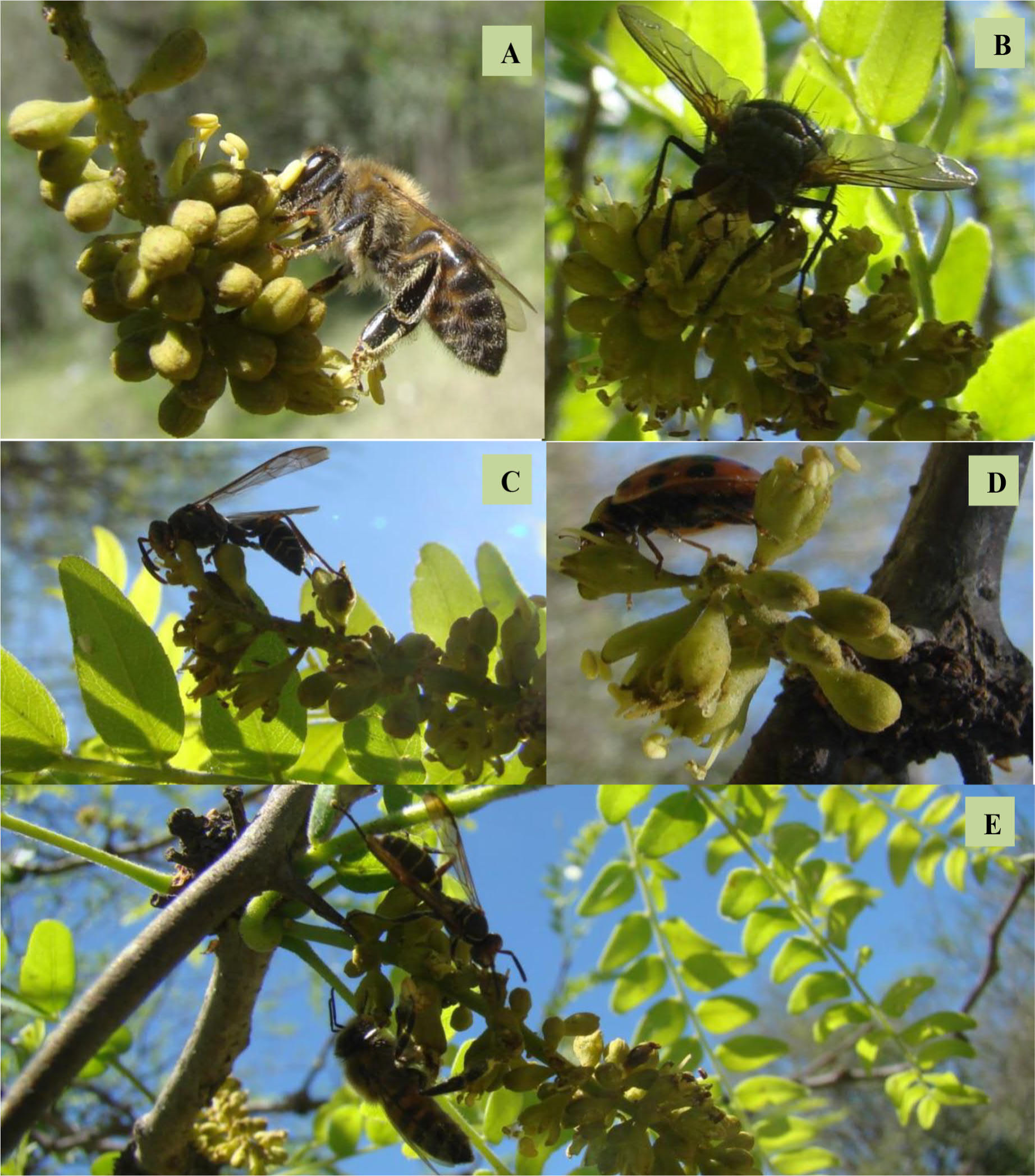 | Ruiz, Leda Silvera T; Amarilla, Leonardo D; Torres, Carolina; Košútová, Dominika; Konôpková, Jana; Ferus, Peter; Galetto, Leonardo Reproductive biology of the invasive Gleditsia triacanthos L. (Fabaceae) Journal Article Flora : morphology, distribution, functional ecology of plants, 288 , 2022, ISSN: ISSN 0367-2530. Abstract | Links | BibTeX @article{Ruiz2022,
title = {Reproductive biology of the invasive \textit{Gleditsia triacanthos} L. (Fabaceae)},
author = {Leda T. Silvera Ruiz and Leonardo D. Amarilla and Carolina Torres and Dominika Košútová and Jana Konôpková and Peter Ferus and Leonardo Galetto},
doi = {10.1016/j.flora.2022.152010},
issn = {ISSN 0367-2530},
year = {2022},
date = {2022-01-24},
journal = {Flora : morphology, distribution, functional ecology of plants},
volume = {288},
abstract = {Biotic invasions constitute a threat for natural communities, affecting ecological and evolutionary integrity of natural ecosystems. Gleditsia triacanthos is an invasive species in many regions of the world. In Argentina, its populations are expanding over native vegetation of different ecoregions. The aim of this work is to study the reproductive biology of the invasive honey locust, characterizing the reproductive individuals, the assemblage of pollinators, the pollination process, the compatibility system, and the reproductive success. Considering that G. triacanthos could be characterized as a novel invader in Argentina and plant-pollinator interactions could be important to facilitate plant invasions, we expect to find (a) an assembly of generalist floral visitors that promote pollination; (b) that fruits and seeds could be produced through self- (autogamy) or cross-pollination (mediated by pollinators); (c) that pollinators can increase reproductive success of exposed flowers compared to those experimentally isolated from pollinators. The studied populations (Córdoba Province, central Argentina) can be characterized as polygamous andro-dioecious, with a higher proportion of male individuals. Although honeybees were the most frequent pollinator, all floral visitors could be potential pollinators and the honey locust can be characterized as pollinator-generalist. G. triacanthos produces fruits and seeds by spontaneous self-pollination, but a higher reproductive success was observed after hand cross- or natural pollinations. Producing both self- and cross-pollinated seeds could be advantageous for this species during different stages of the invasion process. The generalist pollination system presented by G. triacanthos, the high production of pollen by male individuals compared to the individuals with perfect flowers, and the higher fruit and seed set by cross- or natural pollinated flowers are all traits favouring the invasion process. These reproductive traits could be considered when designing management strategies to control the expansion of this invasive species.},
keywords = {},
pubstate = {published},
tppubtype = {article}
}
Biotic invasions constitute a threat for natural communities, affecting ecological and evolutionary integrity of natural ecosystems. Gleditsia triacanthos is an invasive species in many regions of the world. In Argentina, its populations are expanding over native vegetation of different ecoregions. The aim of this work is to study the reproductive biology of the invasive honey locust, characterizing the reproductive individuals, the assemblage of pollinators, the pollination process, the compatibility system, and the reproductive success. Considering that G. triacanthos could be characterized as a novel invader in Argentina and plant-pollinator interactions could be important to facilitate plant invasions, we expect to find (a) an assembly of generalist floral visitors that promote pollination; (b) that fruits and seeds could be produced through self- (autogamy) or cross-pollination (mediated by pollinators); (c) that pollinators can increase reproductive success of exposed flowers compared to those experimentally isolated from pollinators. The studied populations (Córdoba Province, central Argentina) can be characterized as polygamous andro-dioecious, with a higher proportion of male individuals. Although honeybees were the most frequent pollinator, all floral visitors could be potential pollinators and the honey locust can be characterized as pollinator-generalist. G. triacanthos produces fruits and seeds by spontaneous self-pollination, but a higher reproductive success was observed after hand cross- or natural pollinations. Producing both self- and cross-pollinated seeds could be advantageous for this species during different stages of the invasion process. The generalist pollination system presented by G. triacanthos, the high production of pollen by male individuals compared to the individuals with perfect flowers, and the higher fruit and seed set by cross- or natural pollinated flowers are all traits favouring the invasion process. These reproductive traits could be considered when designing management strategies to control the expansion of this invasive species. |
 | Dimitrova, Anastazija; Csilléry, Katalin; Klisz, Marcin; Lévesque, Mathieu; Heinrichs, Steffi; Cailleret, Maxime; Andivia, Enrique; Madsen, Palle; Böhenius, Henrik; Cvjetkovic, Branislav; Cuyper, Bart De; de Dato, Giovanbattista; Ferus, Peter; Heinze, Berthold; Ivetić, Vladan; Köbölkuti, Zoltan; Lazarević, Jelena; Lazdina, Dagnija; Maaten, Tiit; Makovskis, Kristaps; Milovanović, Jelena; Monteiro, Antonio T; Nonić, Marina; Place, Simon; Puchalka, Radoslaw; Montagnoli, Antonio Risks, benefits, and knowledge gaps of non-native tree species in Europe Journal Article Frontiers in Ecology and Evolution, 10 , 2022, ISSN: 2296-701X. Links | BibTeX @article{Dimitrova_2022,
title = {Risks, benefits, and knowledge gaps of non-native tree species in Europe},
author = {Anastazija Dimitrova and Katalin Csilléry and Marcin Klisz and Mathieu Lévesque and Steffi Heinrichs and Maxime Cailleret and Enrique Andivia and Palle Madsen and Henrik Böhenius and Branislav Cvjetkovic and Bart De Cuyper and Giovanbattista de Dato and Peter Ferus and Berthold Heinze and Vladan Ivetić and Zoltan Köbölkuti and Jelena Lazarević and Dagnija Lazdina and Tiit Maaten and Kristaps Makovskis and Jelena Milovanović and Antonio T Monteiro and Marina Nonić and Simon Place and Radoslaw Puchalka and Antonio Montagnoli},
url = {http://dx.doi.org/10.3389/fevo.2022.908464},
doi = {10.3389/fevo.2022.908464},
issn = {2296-701X},
year = {2022},
date = {2022-01-01},
journal = {Frontiers in Ecology and Evolution},
volume = {10},
publisher = {Frontiers Media SA},
keywords = {},
pubstate = {published},
tppubtype = {article}
}
|
2020
|
 | Ferus, Peter; Hoťka, Peter; Košútová, Dominika; Konôpková, Jana Invasions of alien woody plant taxa across a cluster of villages neighbouring the Mlyňany Arboretum (SW Slovakia) Journal Article Folia Oecologica, 47 (2), pp. 121-130, 2020. Abstract | Links | BibTeX @article{Ferus2020,
title = {Invasions of alien woody plant taxa across a cluster of villages neighbouring the Mlyňany Arboretum (SW Slovakia)},
author = {Peter Ferus and Peter Hoťka and Dominika Košútová and Jana Konôpková},
url = {http://ife.sk/wp-content/uploads/2020/09/foecol-2020-0005.pdf},
doi = {10.2478/foecol-2020-0014},
year = {2020},
date = {2020-11-24},
journal = {Folia Oecologica},
volume = {47},
number = {2},
pages = {121-130},
abstract = {Ornamental plantations in cities and particularly botanical gardens and arboreta are rich sources of alien flora. Mlyňany Arboretum, established in 1892, cultivates 1049 non-native woody plant species on the area of 67 ha. In this work we answered following questions: 1. How many taxa are spontaneously spreading in the arboretum and how is the spreading intensity related to their ecological demands and reproduction traits? 2. How many taxa appear behind the fence? 3. How far from the arboretum they can get? 4. Do private gardens and historical aristocratic park in the studied village cluster contribute to species escapes from culture? 5. Which from the widely spread taxa can represent future risk of invasiveness on the national level? We found that about one tenth of taxa spread across the arboretum (particularly Cotoneaster spp., Prunus laurocerasus, P. serotina and Quercus rubra) and number of their seedlings corresponded only with the mother plant number. Almost one third of these species left the arboretum and their seedlings were observed in distance up to 500 m from the village (mainly Mahonia aquifolium, P. serotina). Private gardens were a large source of Juglans regia seedlings, frequency of which decreased with the distance from villages (no species escaped from the historical park). Weed risk assessment revealed potential invasion danger only for Amorpha fruticosa.},
keywords = {},
pubstate = {published},
tppubtype = {article}
}
Ornamental plantations in cities and particularly botanical gardens and arboreta are rich sources of alien flora. Mlyňany Arboretum, established in 1892, cultivates 1049 non-native woody plant species on the area of 67 ha. In this work we answered following questions: 1. How many taxa are spontaneously spreading in the arboretum and how is the spreading intensity related to their ecological demands and reproduction traits? 2. How many taxa appear behind the fence? 3. How far from the arboretum they can get? 4. Do private gardens and historical aristocratic park in the studied village cluster contribute to species escapes from culture? 5. Which from the widely spread taxa can represent future risk of invasiveness on the national level? We found that about one tenth of taxa spread across the arboretum (particularly Cotoneaster spp., Prunus laurocerasus, P. serotina and Quercus rubra) and number of their seedlings corresponded only with the mother plant number. Almost one third of these species left the arboretum and their seedlings were observed in distance up to 500 m from the village (mainly Mahonia aquifolium, P. serotina). Private gardens were a large source of Juglans regia seedlings, frequency of which decreased with the distance from villages (no species escaped from the historical park). Weed risk assessment revealed potential invasion danger only for Amorpha fruticosa. |
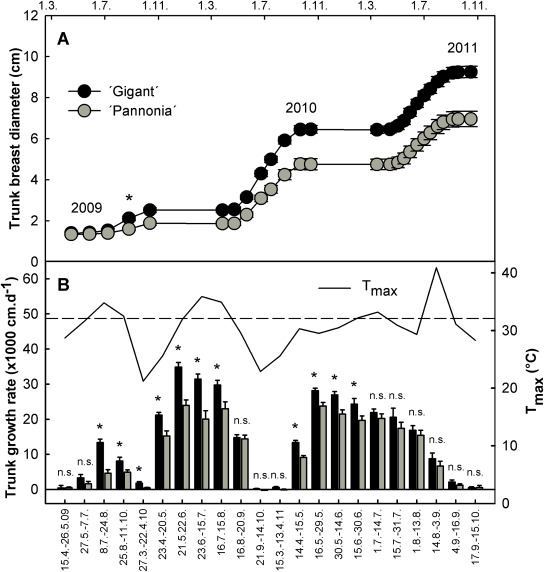 | Ferus, Peter; Hnilička, František; Hniličková, Helena; Kurjak, Daniel; Kmeť, Jaroslav; Otepka, Pavol; Gubiš, Jozef; Havrlentová, Michaela; Malbeck, Jiří; Konôpková, Jana Productivity and heat-stress tolerance in Canadian poplar (Populus × canadensis Moench) clones with different ecological optimum Journal Article Biomass and Bioenergy, 138 , 2020, ISSN: 0961-9534. Abstract | Links | BibTeX @article{Ferus2020b,
title = {Productivity and heat-stress tolerance in Canadian poplar (\textit{Populus × canadensis} Moench) clones with different ecological optimum},
author = {Peter Ferus and František Hnilička and Helena Hniličková and Daniel Kurjak and Jaroslav Kmeť and Pavol Otepka and Jozef Gubiš and Michaela Havrlentová and Jiří Malbeck and Jana Konôpková},
doi = {10.1016/j.biombioe.2020.105605},
issn = {0961-9534},
year = {2020},
date = {2020-07-01},
journal = {Biomass and Bioenergy},
volume = {138},
abstract = {Cultivation of fast growing poplar (Populus sp.) clones represents an effective means for reaching the 2020 target of the EU-28 renewable energy production. However, considering the continuous climate change, their growth can be markedly affected by summer heat stress episodes in Slovakia. Therefore, in this work two Canadian poplar (Populus × canadensis Moench) clones of different ecological optimum, ‘Gigant' and ‘Pannonia', were investigated in respect of productivity and heat stress tolerance. After three-year cultivation, tree height in the clone ‘Gigant' was 8.9 m, breast trunk diameter 9.3 cm and trunk volume 0.021 m3 compared to 7.9 m, 7.0 cm and 0.012 m3 in clone ‘Pannonia' (despite of relatively more stable trunk growth rate in summer). Trunks of the latter clone contained 12% bark (vs. 10% in ‘Gigant'), 1.5% ash in the wood (vs. 3%) and showed significantly larger wood density (440 vs. 380 kg m−3) but lower wood free energy content (14.5 vs. 16 MJ kg−1). Both of clones were proved to be diploids (2x). Clone ‘Pannonia' exhibited larger heat stress tolerance, as tested in leaves of different developmental stage exposed to 40 °C using chlorophyll fluorescence technique (decreasing from mature to juvenile leaves), lower specific leaf area and higher leaf carotenoid and cytokinin (particularly BAP derivatives) concentration. In spite of lower heat stress tolerance and higher ash content, clone ‘Gigant' showed larger productivity than clone ‘Pannonia', suggesting potential of the latter for cultivation in much more stressful conditions.},
keywords = {},
pubstate = {published},
tppubtype = {article}
}
Cultivation of fast growing poplar (Populus sp.) clones represents an effective means for reaching the 2020 target of the EU-28 renewable energy production. However, considering the continuous climate change, their growth can be markedly affected by summer heat stress episodes in Slovakia. Therefore, in this work two Canadian poplar (Populus × canadensis Moench) clones of different ecological optimum, ‘Gigant' and ‘Pannonia', were investigated in respect of productivity and heat stress tolerance. After three-year cultivation, tree height in the clone ‘Gigant' was 8.9 m, breast trunk diameter 9.3 cm and trunk volume 0.021 m3 compared to 7.9 m, 7.0 cm and 0.012 m3 in clone ‘Pannonia' (despite of relatively more stable trunk growth rate in summer). Trunks of the latter clone contained 12% bark (vs. 10% in ‘Gigant'), 1.5% ash in the wood (vs. 3%) and showed significantly larger wood density (440 vs. 380 kg m−3) but lower wood free energy content (14.5 vs. 16 MJ kg−1). Both of clones were proved to be diploids (2x). Clone ‘Pannonia' exhibited larger heat stress tolerance, as tested in leaves of different developmental stage exposed to 40 °C using chlorophyll fluorescence technique (decreasing from mature to juvenile leaves), lower specific leaf area and higher leaf carotenoid and cytokinin (particularly BAP derivatives) concentration. In spite of lower heat stress tolerance and higher ash content, clone ‘Gigant' showed larger productivity than clone ‘Pannonia', suggesting potential of the latter for cultivation in much more stressful conditions. |
 | Ferus, Peter; Bošiaková, Dominika; Konôpková, Jana; Hoťka, Peter Diverse strategies of rhododendron (Rhododendron sp.) genotypes in the water shortage management Journal Article Acta Scientiarum Polonorum. Hortorum Cultus, 19 (3), pp. 159-165, 2020, ISBN: 1644-0692. Abstract | Links | BibTeX @article{Ferus2020d,
title = {Diverse strategies of rhododendron (Rhododendron sp.) genotypes in the water shortage management},
author = {Peter Ferus and Dominika Bošiaková and Jana Konôpková and Peter Hoťka },
doi = {10.24326/asphc.2020.3.14},
isbn = {1644-0692},
year = {2020},
date = {2020-06-29},
journal = {Acta Scientiarum Polonorum. Hortorum Cultus},
volume = {19},
number = {3},
pages = {159-165},
abstract = {Rhododendrons in numerous gardens in Central Europe are frequently endangered by adverse summer drought periods associated with the climate change. Therefore, in this work drought-resistance strategies in recent genotypes of these highly aesthetic shrubs were investigated. Dehydrated Rhododendron groenlandicum ‘Helma’, R. obtusum ‘Michiko’ and R. hybridum ‘Polarnacht’ showed high initial stomatal conductances (gS), after few days steeply falling to the stable minimum at ca. 20, 85 and 70% leaf relative water content (RWC), respectively. Except of ‘Polarnacht’, they had relatively large specific leaf area and ‘Michiko’ also free proline accumulation. On the other hand, R. repens ‘Scarlet Wonder’ and R. hybridum ‘Red Jack’ started with half gS values, continuously declining 1.5–2 fold longer compared to the first group of genotypes (RWC of ca. 60 and 75%, respectively). Both produced relatively thick leaves but did not show any osmotic adjustment. Among observed drought-resistance strategies, lower and longer period active transpiration with stomata sensitive to the water loss, as found in R. repens ‘Scarlet Wonder’ and R. × hybridum ‘Red Jack’, were accepted as the most effective for drought-affected rhododendron plantations.},
keywords = {},
pubstate = {published},
tppubtype = {article}
}
Rhododendrons in numerous gardens in Central Europe are frequently endangered by adverse summer drought periods associated with the climate change. Therefore, in this work drought-resistance strategies in recent genotypes of these highly aesthetic shrubs were investigated. Dehydrated Rhododendron groenlandicum ‘Helma’, R. obtusum ‘Michiko’ and R. hybridum ‘Polarnacht’ showed high initial stomatal conductances (gS), after few days steeply falling to the stable minimum at ca. 20, 85 and 70% leaf relative water content (RWC), respectively. Except of ‘Polarnacht’, they had relatively large specific leaf area and ‘Michiko’ also free proline accumulation. On the other hand, R. repens ‘Scarlet Wonder’ and R. hybridum ‘Red Jack’ started with half gS values, continuously declining 1.5–2 fold longer compared to the first group of genotypes (RWC of ca. 60 and 75%, respectively). Both produced relatively thick leaves but did not show any osmotic adjustment. Among observed drought-resistance strategies, lower and longer period active transpiration with stomata sensitive to the water loss, as found in R. repens ‘Scarlet Wonder’ and R. × hybridum ‘Red Jack’, were accepted as the most effective for drought-affected rhododendron plantations. |
 | Konôpková, Jana; Košútová, Dominika; Ferus, Peter Genotype-specific requirements for in vitro culture initiation and multiplication of Magnolia taxa Journal Article Folia Oecologica, 47 (1), pp. 34-44, 2020, ISSN: 1336-5266. Abstract | Links | BibTeX @article{Konôpková2020,
title = {Genotype-specific requirements for in vitro culture initiation and multiplication of Magnolia taxa},
author = {Jana Konôpková and Dominika Košútová and Peter Ferus},
url = {http://ife.sk/wp-content/uploads/2016/10/foecol-2020-0005.pdf},
doi = {10.2478/foecol-2020-0005},
issn = {1336-5266},
year = {2020},
date = {2020-04-30},
journal = {Folia Oecologica},
volume = {47},
number = {1},
pages = {34-44},
abstract = {The influence of basal media composition, concentration of plant growth regulators (PGRs), and the developmental stage of primary explants (dormancy, stage of bud opening and fruit ripening) on the initiation phase of nine Magnolia genotypes, including M. stellata /Sieb. & Zucc./Maxim., M. × soulangeana 'Rustica Rubra', M. denudata Desr., M. × soulangeana 'Alexandrina', M. liliiflora Desr., M. officinalis var. biloba Rehd. & Wils., M. salicifolia Maxim., M. × soulangeana 'Lennei', and M. kobus DC, was evaluated. The highest efficiency of primary culture initiation of seven Magnolia genotypes (except for M. liliiflora and M. salicifolia) was achieved from primary explants collected in the bud opening stage. A high positive correlation was found between total tannins and efficiency of the primary culture initiation at the fruit ripening stage (r = 0.833). Standardi and Catalano medium (S2) with 0.5 mg l–1 of 6-benzylaminopurine (BAP) was the most appropriate for multiplication of M. × soulangeana 'Alexandrina', whereas tissue cultures of M. × soulangeana 'Lennei' proliferated and grew better on S2 medium with 1.0 mg l–1 of BAP and 1.0 g l–1 of polyvinylpyrrolidone. The requirements for the composition of basal media and concentration of PGRs in the initiation and multiplication stages of micropropagation of various Magnolia species and cultivars are genotype-specific.},
keywords = {},
pubstate = {published},
tppubtype = {article}
}
The influence of basal media composition, concentration of plant growth regulators (PGRs), and the developmental stage of primary explants (dormancy, stage of bud opening and fruit ripening) on the initiation phase of nine Magnolia genotypes, including M. stellata /Sieb. & Zucc./Maxim., M. × soulangeana 'Rustica Rubra', M. denudata Desr., M. × soulangeana 'Alexandrina', M. liliiflora Desr., M. officinalis var. biloba Rehd. & Wils., M. salicifolia Maxim., M. × soulangeana 'Lennei', and M. kobus DC, was evaluated. The highest efficiency of primary culture initiation of seven Magnolia genotypes (except for M. liliiflora and M. salicifolia) was achieved from primary explants collected in the bud opening stage. A high positive correlation was found between total tannins and efficiency of the primary culture initiation at the fruit ripening stage (r = 0.833). Standardi and Catalano medium (S2) with 0.5 mg l–1 of 6-benzylaminopurine (BAP) was the most appropriate for multiplication of M. × soulangeana 'Alexandrina', whereas tissue cultures of M. × soulangeana 'Lennei' proliferated and grew better on S2 medium with 1.0 mg l–1 of BAP and 1.0 g l–1 of polyvinylpyrrolidone. The requirements for the composition of basal media and concentration of PGRs in the initiation and multiplication stages of micropropagation of various Magnolia species and cultivars are genotype-specific. |
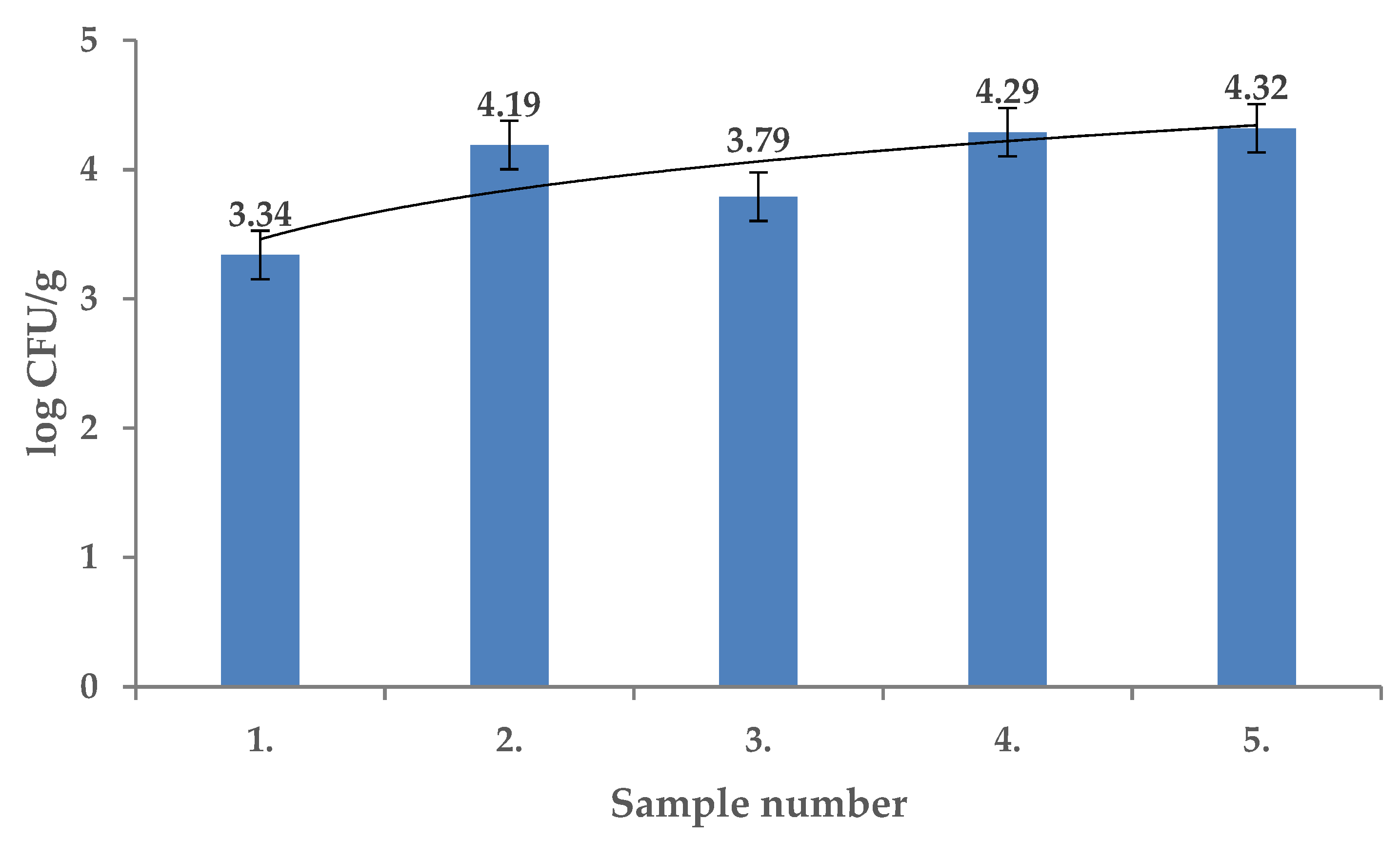 | Rovná, Katarína; Ivanišová, Eva; Žiarovská, Jana; Ferus, Peter; Terentjeva, Margarita; Kowalczewski, Przemysław Łukasz; Kačániová, Miroslava Characterization of rosa canina fruits collected in urban areas of Slovakia. Genome size, IPBS profiles and antioxidant and antimicrobial activities Journal Article Molecules, 25 (8), 2020, ISSN: 1420-3049. Abstract | Links | BibTeX @article{Rovná2020,
title = {Characterization of \textit{rosa canina} fruits collected in urban areas of Slovakia. Genome size, IPBS profiles and antioxidant and antimicrobial activities},
author = {Katarína Rovná and Eva Ivanišová and Jana Žiarovská and Peter Ferus and Margarita Terentjeva and Przemysław Łukasz Kowalczewski and Miroslava Kačániová},
doi = {10.3390/molecules25081888},
issn = {1420-3049},
year = {2020},
date = {2020-04-19},
journal = {Molecules},
volume = {25},
number = {8},
abstract = {The studies of plant bacterial endophytes, colonizing the plant tissues without any signs of diseases, are essential for understanding of ecological interactions. The aim of our study is to detect microbiological contamination and to assess the antimicrobial, antioxidant activity, total phenolic, carotenoid content, genome size, and ploidy of non-cultivated Rosa canina sampled from urban areas. Samples of Rosa canina fruits were collected in three locations in Slovakia. The highest total viable count and the Enterobacteriaceae count in fruits were 4.32 log CFU/g and 4.29 log CFU/g, respectively. Counts of the mesophilic anaerobic sporulating bacteria, Pseudomonas spp., and of the microscopic fungi and yeasts were 3.00, 2.15 log CFU/g, 3.65 log CFU/g, and 2.76 log CFU/g, respectively. Regarding the antimicrobial activity, Escherichia coli and Klebsiela oxytoca were the most sensitive species among the assayed microorganisms to the treatment with the ethanolic extracts of Rosa canina fruits. The fruits were rich in bioactive compounds, polyphenols, and carotenoids, that could be related to their antioxidant activity. Genome sizes of analyzed samples ranged from 2.3 to 2.96. DNA-based fingerprinting obtained by iPBS markers of the Rosa canina var. lapidicola Heinr. Braun., was characterized by some distinctive inserted loci. An interdisciplinary study was performed for the dog roses from different parts of Slovakia that resulted in deeper characterization of this species.},
keywords = {},
pubstate = {published},
tppubtype = {article}
}
The studies of plant bacterial endophytes, colonizing the plant tissues without any signs of diseases, are essential for understanding of ecological interactions. The aim of our study is to detect microbiological contamination and to assess the antimicrobial, antioxidant activity, total phenolic, carotenoid content, genome size, and ploidy of non-cultivated Rosa canina sampled from urban areas. Samples of Rosa canina fruits were collected in three locations in Slovakia. The highest total viable count and the Enterobacteriaceae count in fruits were 4.32 log CFU/g and 4.29 log CFU/g, respectively. Counts of the mesophilic anaerobic sporulating bacteria, Pseudomonas spp., and of the microscopic fungi and yeasts were 3.00, 2.15 log CFU/g, 3.65 log CFU/g, and 2.76 log CFU/g, respectively. Regarding the antimicrobial activity, Escherichia coli and Klebsiela oxytoca were the most sensitive species among the assayed microorganisms to the treatment with the ethanolic extracts of Rosa canina fruits. The fruits were rich in bioactive compounds, polyphenols, and carotenoids, that could be related to their antioxidant activity. Genome sizes of analyzed samples ranged from 2.3 to 2.96. DNA-based fingerprinting obtained by iPBS markers of the Rosa canina var. lapidicola Heinr. Braun., was characterized by some distinctive inserted loci. An interdisciplinary study was performed for the dog roses from different parts of Slovakia that resulted in deeper characterization of this species. |
 | Ferus, Peter; Menčik, Karolina; Konôpková, Jana Allelopathic potential of Juglans nigra L. to control the invasive tree-of-heaven (Ailanthus altissima (Mill.) Swingle) Journal Article Allelopathy Journal, 49 (2), pp. 177-188, 2020, ISSN: 0971-4693. Links | BibTeX @article{Ferus2020c,
title = {Allelopathic potential of \textit{Juglans nigra} L. to control the invasive tree-of-heaven (\textit{Ailanthus altissima} (Mill.) Swingle)},
author = {Peter Ferus and Karolina Menčik and Jana Konôpková },
doi = {10.26651/allelo.j/2020-49-2-1263},
issn = {0971-4693},
year = {2020},
date = {2020-01-01},
journal = {Allelopathy Journal},
volume = {49},
number = {2},
pages = {177-188},
keywords = {},
pubstate = {published},
tppubtype = {article}
}
|
2019
|
 | Ferus, Peter; Bošiaková, Dominika; Konôpková, Jana; Hoťka, Peter; Kósa, Géza; Melnykova, Nataliya; Kots, Segiy Allelopathic interactions of invasive black locust (Robinia pseudoacacia L.) with secondary aliens: the physiological background Journal Article Acta Physiologiae Plantarum, 41 (11), 2019, ISSN: 0137-5881. Abstract | Links | BibTeX @article{Ferus2019b,
title = {Allelopathic interactions of invasive black locust (\textit{Robinia pseudoacacia} L.) with secondary aliens: the physiological background},
author = {Peter Ferus and Dominika Bošiaková and Jana Konôpková and Peter Hoťka and Géza Kósa and Nataliya Melnykova and Segiy Kots },
doi = {10.1007/s11738-019-2974-y},
issn = {0137-5881},
year = {2019},
date = {2019-11-09},
journal = {Acta Physiologiae Plantarum},
volume = {41},
number = {11},
abstract = {Despite of numerous benefits, black locust (Robinia pseudoacacia L.) is an invasive tree species in Slovakia and Hungary. Recently, secondary local invasions of black locust plantations by black cherry (Prunus serotina Ehrh.) and common hackberry (Celtis occidentalis L.) have been observed in these countries. In this study, we describe these unique tree-to-tree interactions directly in the field as well as simulated in the laboratory (1% water extracts from leaves and twigs applied on leaf and soil). In the field, we observed no effect on tree height and trunk diameter as well as leaf metabolic parameters caused by black cherry. However, the laboratory experiment showed a reduction in nodulation, and thus N fixation rate per plant, which did not mirror in the shoot and root dry matter (DM) production. On the other hand, common hackberry significantly affected tree height as well as leaf amino acid and total nitrogen concentration, but not the content of soluble sugars and hydrogen peroxide in the field. The laboratory experiment revealed significant reductions in nodulation, N fixation rate per plant, shoot and root DM and leaf hydrogen peroxide, nevertheless, a noticeable soluble protein accumulation. Thus, we can conclude that common hackberry, but not black cherry, can effectively suppress black locust N metabolism and growth.},
keywords = {},
pubstate = {published},
tppubtype = {article}
}
Despite of numerous benefits, black locust (Robinia pseudoacacia L.) is an invasive tree species in Slovakia and Hungary. Recently, secondary local invasions of black locust plantations by black cherry (Prunus serotina Ehrh.) and common hackberry (Celtis occidentalis L.) have been observed in these countries. In this study, we describe these unique tree-to-tree interactions directly in the field as well as simulated in the laboratory (1% water extracts from leaves and twigs applied on leaf and soil). In the field, we observed no effect on tree height and trunk diameter as well as leaf metabolic parameters caused by black cherry. However, the laboratory experiment showed a reduction in nodulation, and thus N fixation rate per plant, which did not mirror in the shoot and root dry matter (DM) production. On the other hand, common hackberry significantly affected tree height as well as leaf amino acid and total nitrogen concentration, but not the content of soluble sugars and hydrogen peroxide in the field. The laboratory experiment revealed significant reductions in nodulation, N fixation rate per plant, shoot and root DM and leaf hydrogen peroxide, nevertheless, a noticeable soluble protein accumulation. Thus, we can conclude that common hackberry, but not black cherry, can effectively suppress black locust N metabolism and growth. |
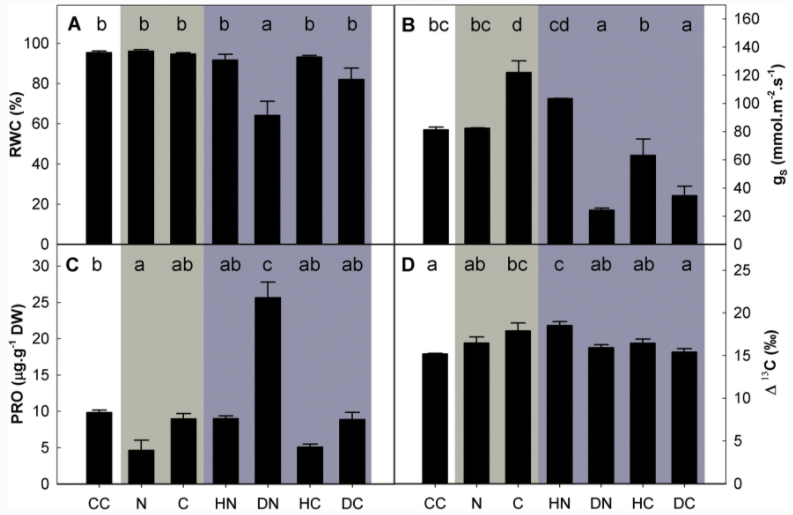 | Ferus, Peter; Barta, Marek; Konôpková, Jana Endophytic fungus Beauveria bassiana can enhance drought tolerance in red oak seedlings Journal Article Trees-Structure and Function, 33 (4), pp. 1179–1186, 2019, ISSN: 0931-1890. Abstract | Links | BibTeX @article{Ferus2019,
title = {Endophytic fungus \textit{Beauveria bassiana} can enhance drought tolerance in red oak seedlings},
author = {Peter Ferus and Marek Barta and Jana Konôpková },
doi = {10.1007/s00468-019-01854-1},
issn = {0931-1890},
year = {2019},
date = {2019-05-04},
journal = {Trees-Structure and Function},
volume = {33},
number = {4},
pages = {1179–1186},
abstract = {Endophytic fungi are known to be active in the plant environmental stress alleviation. In this work, we proved the ability of endophytic Beauveria bassiana, which is almost exclusively treated as an entomopathogenic fungus, in mitigating drought stress in dehydrated red oak (Quercus rubra L.) seedlings. Despite small differences between experiments, in general, leaf relative water content and stomatal conductance were less reduced (ca. 50% and 15%, respectively), free proline did not accumulate over the control level, carbon isotope 13C discrimination/water use efficiency was not affected and root growth was stimulated at a similar plant transpiration area in the endophyte-colonised individuals. Regression analysis revealed that the root growth stimulation provided by the fungus under drought had the most important effect on their water status.},
keywords = {},
pubstate = {published},
tppubtype = {article}
}
Endophytic fungi are known to be active in the plant environmental stress alleviation. In this work, we proved the ability of endophytic Beauveria bassiana, which is almost exclusively treated as an entomopathogenic fungus, in mitigating drought stress in dehydrated red oak (Quercus rubra L.) seedlings. Despite small differences between experiments, in general, leaf relative water content and stomatal conductance were less reduced (ca. 50% and 15%, respectively), free proline did not accumulate over the control level, carbon isotope 13C discrimination/water use efficiency was not affected and root growth was stimulated at a similar plant transpiration area in the endophyte-colonised individuals. Regression analysis revealed that the root growth stimulation provided by the fungus under drought had the most important effect on their water status. |
2018
|
 | Ferus, P; Sgherri, C Watermelon leaf antioxidant defence under sea-like water irrigation differs with growth vigour Journal Article Agrochimica, 62 (1), pp. 47-54, 2018. BibTeX @article{Ferus2018,
title = {Watermelon leaf antioxidant defence under sea-like water irrigation differs with growth vigour},
author = {P. Ferus and C. Sgherri},
year = {2018},
date = {2018-01-01},
journal = {Agrochimica},
volume = {62},
number = {1},
pages = {47-54},
keywords = {},
pubstate = {published},
tppubtype = {article}
}
|
2017
|
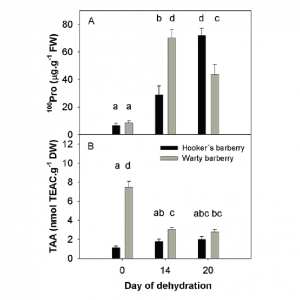 | Ferus, P; Bošiaková, D; Konôpková, J; Hoťka, P; Keet, J H Hooker’s or warty barberry? Physiological background analysis for choosing the right one into ornamental plantations endangered by drought. Journal Article Acta Universitatis Agriculturae et Silviculturae Mendelianae Brunensis, 65 (2), pp. 411-418, 2017. Links | BibTeX @article{Ferus2017,
title = {Hooker’s or warty barberry? Physiological background analysis for choosing the right one into ornamental plantations endangered by drought.},
author = {P. Ferus and D. Bošiaková and J. Konôpková and P. Hoťka and J.H. Keet},
url = {https://acta.mendelu.cz/65/2/0411/},
doi = {https://doi.org/10.11118/actaun201765020411},
year = {2017},
date = {2017-01-01},
journal = {Acta Universitatis Agriculturae et Silviculturae Mendelianae Brunensis},
volume = {65},
number = {2},
pages = {411-418},
keywords = {},
pubstate = {published},
tppubtype = {article}
}
|
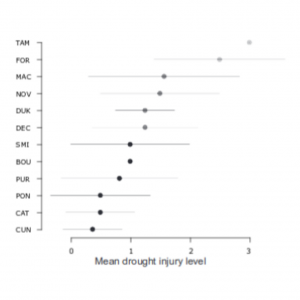 | Ferus, P; Hoťka, P; Konôpková, J Drought and frost tolerance in rhododendron collection of the Mlyňany Arboretum (Slovakia): a screening for future climate Journal Article Folia Oecologica, 44 (2), pp. 87-95, 2017, ISBN: 1336-5266. Abstract | Links | BibTeX @article{Ferus2017b,
title = {Drought and frost tolerance in rhododendron collection of the Mlyňany Arboretum (Slovakia): a screening for future climate},
author = {P. Ferus and P. Hoťka and J. Konôpková},
url = {http://ife.sk/wp-content/uploads/2016/10/foecol-2017-0004-1.pdf},
doi = {10.1515/foecol-2017-0011},
isbn = {1336-5266},
year = {2017},
date = {2017-01-01},
journal = {Folia Oecologica},
volume = {44},
number = {2},
pages = {87-95},
abstract = {Rhododendrons are jewels of the Mlyňany Arboretum, Institute of Forest Ecology of the Slovak Academy of Sciences (IFE SAS). Blossoming in May, they attract thousands of visitors. But recently these woody plants have much suffered from climatic extremes such as summer droughts and winter frosts, associated with the advancing climate change. To assess the rhododendron collection´s stability, its drought and frost injury level were tested in field, in summer 2015 and winter 2017, respectively. The tested parameters were: leaf wilting and electrolyte leakage combined with shrub leaf area, insolation level and overall health state. We found that the drought effect was strong or very strong in only ca. 30% rhododendron species and ca. 10% rhododendron cultivars, and that around 60% shrubs showed no or only moderate symptoms of water deficit. The drought injury level was only associated with the genotype. The most tolerant / sensitive genotypes, commonly occurring in the park, were: R. catawbiense, R. ponticum, R. smirnowii, cv. ´Boursault´, cv. ´Cunningham´s White´ and cv. ´Purpureum Elegans´ / R. fortunei and cv. ´Tamarindos´. On the other hand, the most frequent response to frost in the observed rhododendron genotypes was moderate injury (28 and 37% for species and cultivars, respectively), nevertheless more than 18% species and almost 6% cultivars exhibited strong frost damage. Despite absence of significant differences in the factor-response between the species, we may suggest this decreasing sequence of the genotypes ordered according to their frost resistance: genotypes: cv. ´Cunningham´s White´ > R. decorum > R. fortunei and cv. ´Duke of York´ > R. smirnowii > cvs. ´Purpureum Elegans´and ´Tamarindos´ > R. macrophyllum and cv. ´Nova Zembla´ > R. catawbiense > R. ponticum. These results have been compared with similar works in rhododendron species/cultivars as well as suggested species drought/frost tolerance derived from climatic conditions in the area of their natural distribution.},
keywords = {},
pubstate = {published},
tppubtype = {article}
}
Rhododendrons are jewels of the Mlyňany Arboretum, Institute of Forest Ecology of the Slovak Academy of Sciences (IFE SAS). Blossoming in May, they attract thousands of visitors. But recently these woody plants have much suffered from climatic extremes such as summer droughts and winter frosts, associated with the advancing climate change. To assess the rhododendron collection´s stability, its drought and frost injury level were tested in field, in summer 2015 and winter 2017, respectively. The tested parameters were: leaf wilting and electrolyte leakage combined with shrub leaf area, insolation level and overall health state. We found that the drought effect was strong or very strong in only ca. 30% rhododendron species and ca. 10% rhododendron cultivars, and that around 60% shrubs showed no or only moderate symptoms of water deficit. The drought injury level was only associated with the genotype. The most tolerant / sensitive genotypes, commonly occurring in the park, were: R. catawbiense, R. ponticum, R. smirnowii, cv. ´Boursault´, cv. ´Cunningham´s White´ and cv. ´Purpureum Elegans´ / R. fortunei and cv. ´Tamarindos´. On the other hand, the most frequent response to frost in the observed rhododendron genotypes was moderate injury (28 and 37% for species and cultivars, respectively), nevertheless more than 18% species and almost 6% cultivars exhibited strong frost damage. Despite absence of significant differences in the factor-response between the species, we may suggest this decreasing sequence of the genotypes ordered according to their frost resistance: genotypes: cv. ´Cunningham´s White´ > R. decorum > R. fortunei and cv. ´Duke of York´ > R. smirnowii > cvs. ´Purpureum Elegans´and ´Tamarindos´ > R. macrophyllum and cv. ´Nova Zembla´ > R. catawbiense > R. ponticum. These results have been compared with similar works in rhododendron species/cultivars as well as suggested species drought/frost tolerance derived from climatic conditions in the area of their natural distribution. |
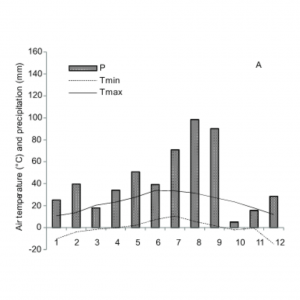 | Ferus, P; Konôpková, J; Bošiaková, D; Hoťka, P Effective rhododendron propagation through stem cuttings Journal Article Journal of Applied Horticulture, 19 (3), pp. 226-229, 2017, ISBN: 1336-5266. BibTeX @article{Ferus2017d,
title = {Effective rhododendron propagation through stem cuttings},
author = {P. Ferus and J. Konôpková and D. Bošiaková and P. Hoťka},
isbn = {1336-5266},
year = {2017},
date = {2017-01-01},
journal = {Journal of Applied Horticulture},
volume = {19},
number = {3},
pages = {226-229},
keywords = {},
pubstate = {published},
tppubtype = {article}
}
|
2015
|
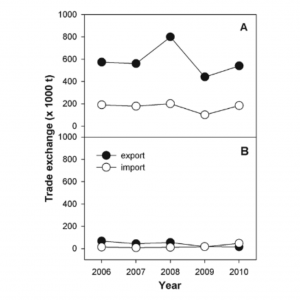 | Ferus, P; Sirbu, C; Eliáš, Jun P; Konôpková, J; Ďurišová, Ľ; Samuil, C; Oprea, A Reciprocal contamination by invasive plants: analysis of trade exchange between Slovakia and Romania Journal Article Biologia, 70 (7), pp. 893–904, 2015. Links | BibTeX @article{P.2015,
title = {Reciprocal contamination by invasive plants: analysis of trade exchange between Slovakia and Romania},
author = {P. Ferus and C. Sirbu and P. Jun Eliáš and J. Konôpková and Ľ. Ďurišová and C. Samuil and A. Oprea},
url = {https://www.degruyter.com/view/j/biolog.2015.70.issue-7/biolog-2015-0102/biolog-2015-0102.xml},
year = {2015},
date = {2015-08-25},
journal = {Biologia},
volume = {70},
number = {7},
pages = {893–904},
keywords = {},
pubstate = {published},
tppubtype = {article}
}
|
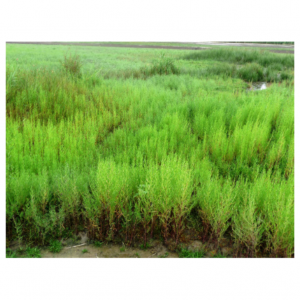 | Sirbu, C; Ferus, P; Eliáš, Jun P; Samuil, C; Oprea, A Symphyotrichum ciliatum in Romania: trends of spread and invaded plant communities. Journal Article Open Life Sciences, 10 (1), pp. 159–176, 2015. Links | BibTeX @article{C.2015,
title = {\textit{Symphyotrichum ciliatum} in Romania: trends of spread and invaded plant communities.},
author = {C. Sirbu and P. Ferus and P. Jun Eliáš and C. Samuil and A. Oprea},
url = {https://www.degruyter.com/view/j/biol.2015.10.issue-1/biol-2015-0018/biol-2015-0018.xml},
year = {2015},
date = {2015-03-16},
journal = {Open Life Sciences},
volume = {10},
number = {1},
pages = {159–176},
keywords = {},
pubstate = {published},
tppubtype = {article}
}
|
2013
|
 | Ferus, P; Barta, M; Konôpková, J; Turčeková, S; Maňka, P; Bibeň, T Diversity in honey locust (Gleditsia triacanthos L.) seed traits across Danube basin Journal Article Folia Oecologica, 40 (2), pp. 163-169, 2013, ISSN: 1336-5266. Abstract | Links | BibTeX @article{Ferus2013c,
title = {Diversity in honey locust (Gleditsia triacanthos L.) seed traits across Danube basin},
author = {P. Ferus and M. Barta and J. Konôpková and S. Turčeková and P. Maňka and T. Bibeň},
url = {http://ife.sk/wp-content/uploads/2016/10/Ferus.pdf},
issn = {1336-5266},
year = {2013},
date = {2013-01-01},
journal = {Folia Oecologica},
volume = {40},
number = {2},
pages = {163-169},
abstract = {Honey locust (Gleditsia triacanthos L.), in the past planted as ornamental, technical or forest tree, is presently considered as casually invasive tree in Danube basin. Since plant invasiveness is usually tightly associated with its reproduction biology, in this work we focused on characterization of seeds from honey locust populations across this area. Analysing seed coat colour, thousand seeds weight (TSW), seed projection area, seed thickness, percentage of germinated seeds and their germination energy, as well as portion of seeds infested by honey locust seed beetle (Megabruchidius tonkineus), consumed part of seeds and their germination ability in relation to seed characteristics, local temperature means and precipitation sums during vegetation period, we came to the following conclusions: seed coat colour diversity decreases with geographical latitude; TSW, seed projection area and thickness were negatively correlated to mean temperature and positively to precipitation sum; between percentage of naturally germinated seeds and TSW as well as seed thickness we found positive correlations; germination energy showed positive relation to mean temperature and a negative one to precipitation sum; and the same relations were observed for infested seeds percentage and consumed seed part. No infested seed was able to germinate. From these results we can conclude that in colder and wetter conditions higher seed germinability, and in warmer and drier conditions enhanced germination energy of seeds supports spreading of this tree species. However, honey locust seed beetle can significantly affect seed germinability in regions with warm and dry summers.},
keywords = {},
pubstate = {published},
tppubtype = {article}
}
Honey locust (Gleditsia triacanthos L.), in the past planted as ornamental, technical or forest tree, is presently considered as casually invasive tree in Danube basin. Since plant invasiveness is usually tightly associated with its reproduction biology, in this work we focused on characterization of seeds from honey locust populations across this area. Analysing seed coat colour, thousand seeds weight (TSW), seed projection area, seed thickness, percentage of germinated seeds and their germination energy, as well as portion of seeds infested by honey locust seed beetle (Megabruchidius tonkineus), consumed part of seeds and their germination ability in relation to seed characteristics, local temperature means and precipitation sums during vegetation period, we came to the following conclusions: seed coat colour diversity decreases with geographical latitude; TSW, seed projection area and thickness were negatively correlated to mean temperature and positively to precipitation sum; between percentage of naturally germinated seeds and TSW as well as seed thickness we found positive correlations; germination energy showed positive relation to mean temperature and a negative one to precipitation sum; and the same relations were observed for infested seeds percentage and consumed seed part. No infested seed was able to germinate. From these results we can conclude that in colder and wetter conditions higher seed germinability, and in warmer and drier conditions enhanced germination energy of seeds supports spreading of this tree species. However, honey locust seed beetle can significantly affect seed germinability in regions with warm and dry summers. |
 | Ferus, P; Pachl, Š; Ľ.Ďurišová, ; Bartošová-Krajčovičová, D; Rovná, K Is there any relation between quantitative traits interesting for ornamental breeding and genome size in dog roses (Rosa sect. Caninae)? Journal Article Folia Oecologica, 40 (1), pp. 11-21, 2013, ISSN: 1336-5266. Abstract | Links | BibTeX @article{Ferus2013d,
title = {Is there any relation between quantitative traits interesting for ornamental breeding and genome size in dog roses (Rosa sect. Caninae)?},
author = {P. Ferus and Š. Pachl and Ľ.Ďurišová and D. Bartošová-Krajčovičová and K. Rovná},
url = {http://ife.sk/wp-content/uploads/2016/10/Ferus-1.pdf},
issn = {1336-5266},
year = {2013},
date = {2013-01-01},
journal = {Folia Oecologica},
volume = {40},
number = {1},
pages = {11-21},
abstract = {To define participation of genome size as well as most important environmental factors in
variability of quantitative characters interesting for ornamental breeding, a collection of wild
dog roses (Rosa sect. Caninae) from Malé Karpaty mountains (localities Modra – Pažite and
Vrbové – Baraní dvor) and Zobor hills (locality Zobor – Lyžiarska lúka) were analysed. We found
a large variability in percentage of leaves longer than 70 mm (16–58%) and those of dark-green
colour (28–78%), portion of half-full flowers (0–6%) and those of intense pink colour (0–100%),
and percentage of hips longer than 20 mm (0–45%) and those of intense red colour (18–48%),
among shrubs. Their genome size ranged from 2.33 to 2.92 pg. Our map survey revealed stagni-
eutric cambisols in Modra – Pažite, haplic luvisols on loess in Vrbové – Baraní dvor, and rendzic/
chromi-rendzic leptosols in Zobor – Lyžiarska lúka (increasing soil quality from stand to stand).
Leaves and flowers grew in conditions of average temperature 15.3 °C (Modra – Pažite and Zobor
– Lyžiarska lúka) and 14.5 °C (Vrbové – Baraní dvor). Precipitation ranged from approximately
300 mm in Modra – Pažite to 400 mm in Zobor – Lyžiarska lúka. Average temperature for hip
formation varied from Zobor – Lyžiarska lúka (19.6 °C) to Modra – Pažite (20.4 °C). In this period,
precipitation sum was round 200 mm in Zobor – Lyžiarska lúka and approximately 250 mm in the
rest two stands. Quantitative traits of all dog roses were generally less correlated to genome size
and environmental factors. However, in R. canina genotypes, leaf length was determined mainly
by genome size (r = 0.437) and temperature (r = –0.316), and leaf colour by temperature (r = 0.777)
and precipitation (r = 0.557), flower richness only by temperature (r = –0.320), flower colour by
temperature (r = 0.606) and soil quality (r = –0.559), and hip colour was defined mainly by
precipitation (r = 0.588), then by temperature (r = 0.427) and genome size (r = –0.362); but
no factor had important influence on hip length. We can conclude that except for leaf size, all
analysed quantitative traits were mainly determined by environmental factors.},
keywords = {},
pubstate = {published},
tppubtype = {article}
}
To define participation of genome size as well as most important environmental factors in
variability of quantitative characters interesting for ornamental breeding, a collection of wild
dog roses (Rosa sect. Caninae) from Malé Karpaty mountains (localities Modra – Pažite and
Vrbové – Baraní dvor) and Zobor hills (locality Zobor – Lyžiarska lúka) were analysed. We found
a large variability in percentage of leaves longer than 70 mm (16–58%) and those of dark-green
colour (28–78%), portion of half-full flowers (0–6%) and those of intense pink colour (0–100%),
and percentage of hips longer than 20 mm (0–45%) and those of intense red colour (18–48%),
among shrubs. Their genome size ranged from 2.33 to 2.92 pg. Our map survey revealed stagni-
eutric cambisols in Modra – Pažite, haplic luvisols on loess in Vrbové – Baraní dvor, and rendzic/
chromi-rendzic leptosols in Zobor – Lyžiarska lúka (increasing soil quality from stand to stand).
Leaves and flowers grew in conditions of average temperature 15.3 °C (Modra – Pažite and Zobor
– Lyžiarska lúka) and 14.5 °C (Vrbové – Baraní dvor). Precipitation ranged from approximately
300 mm in Modra – Pažite to 400 mm in Zobor – Lyžiarska lúka. Average temperature for hip
formation varied from Zobor – Lyžiarska lúka (19.6 °C) to Modra – Pažite (20.4 °C). In this period,
precipitation sum was round 200 mm in Zobor – Lyžiarska lúka and approximately 250 mm in the
rest two stands. Quantitative traits of all dog roses were generally less correlated to genome size
and environmental factors. However, in R. canina genotypes, leaf length was determined mainly
by genome size (r = 0.437) and temperature (r = –0.316), and leaf colour by temperature (r = 0.777)
and precipitation (r = 0.557), flower richness only by temperature (r = –0.320), flower colour by
temperature (r = 0.606) and soil quality (r = –0.559), and hip colour was defined mainly by
precipitation (r = 0.588), then by temperature (r = 0.427) and genome size (r = –0.362); but
no factor had important influence on hip length. We can conclude that except for leaf size, all
analysed quantitative traits were mainly determined by environmental factors. |
2011
|
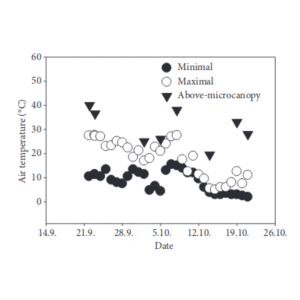 | Ferus, P; Kóňa, Ferusová S J Water dynamics and productivity in dehydrated watermelon plants as modified by red polyethylene mulch Journal Article Turkish Journal of Agriculture and Forestry, 35 (4), pp. 391-402, 2011. Links | BibTeX @article{Ferus2011,
title = {Water dynamics and productivity in dehydrated watermelon plants as modified by red polyethylene mulch},
author = {P. Ferus and S. Ferusová J. Kóňa},
url = {http://dergipark.gov.tr/tbtkagriculture/issue/11590/138161},
year = {2011},
date = {2011-01-01},
journal = {Turkish Journal of Agriculture and Forestry},
volume = {35},
number = {4},
pages = {391-402},
keywords = {},
pubstate = {published},
tppubtype = {article}
}
|
2010
|
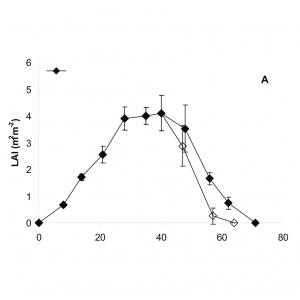 | Ferus, P Radiation use efficiency in spring barley under drought: A crosstalk between survival strategy and canopy structure Journal Article Journal of Central European Agriculture, 11 (1), pp. 83-92, 2010. Links | BibTeX @article{Ferus2010,
title = {Radiation use efficiency in spring barley under drought: A crosstalk between survival strategy and canopy structure},
author = {P. Ferus},
url = {http://hrcak.srce.hr/ojs/index.php/jcea/article/view/814},
doi = {http://dx.doi.org/10.5513/jcea.v11i1.814},
year = {2010},
date = {2010-01-01},
journal = {Journal of Central European Agriculture},
volume = {11},
number = {1},
pages = {83-92},
keywords = {},
pubstate = {published},
tppubtype = {article}
}
|
 | Ferus, P; Ferusová, S; Kóňa, J Water saving ability of artificial cover mulches is most important for watermelon shoot growth under drought Journal Article Contemporary Agriculture / Savremena Poljoprivreda, 2 (3), pp. 11-19, 2010. Links | BibTeX @article{Ferus2010b,
title = {Water saving ability of artificial cover mulches is most important for watermelon shoot growth under drought},
author = {P. Ferus and S. Ferusová and J. Kóňa},
url = {https://www.google.sk/url?sa=t&rct=j&q=&esrc=s&source=web&cd=1&cad=rja&uact=8&ved=0ahUKEwjvkKLgx5_WAhWLEVAKHUxXDNwQFggpMAA&url=http%3A%2F%2Fwww.kb.fapz.uniag.sk%2Fupload%2FPublication%2520links%2FLink%25204.pdf&usg=AFQjCNF9m0a9oadmXR_1hramODPt55tQ6Q},
year = {2010},
date = {2010-01-01},
journal = {Contemporary Agriculture / Savremena Poljoprivreda},
volume = {2},
number = {3},
pages = {11-19},
keywords = {},
pubstate = {published},
tppubtype = {article}
}
|
2008
|
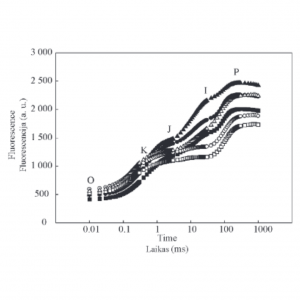 | Ferus, P; Brestič, M; Olšovská, K; Kubová, A Photosystem II thermostability of apple tree leaves: effect of rootstock, crown shape and leaf topology Journal Article Scientific Works, 27 (2), pp. 215-234, 2008. Links | BibTeX @article{Ferus2008,
title = {Photosystem II thermostability of apple tree leaves: effect of rootstock, crown shape and leaf topology},
author = {P. Ferus and M. Brestič and K. Olšovská and A. Kubová},
url = {https://www.google.sk/url?sa=t&rct=j&q=&esrc=s&source=web&cd=1&cad=rja&uact=8&ved=0ahUKEwja3-_vyJ_WAhUGK1AKHWYkDMwQFggsMAA&url=https%3A%2F%2Fwww.researchgate.net%2Fpublication%2F228547362_Photosystem_II_thermostability_of_apple_tree_leaves_effect_of_rootstock_crown_shape_and_leaf_topology&usg=AFQjCNEEM-NRS0gRY-OPTHZWJNtLdazMrg},
year = {2008},
date = {2008-01-01},
journal = {Scientific Works},
volume = {27},
number = {2},
pages = {215-234},
keywords = {},
pubstate = {published},
tppubtype = {article}
}
|
2006
|
 | Ferus, P; Brestič, M; Olšovská, K; Hudec, J Does free putrescine regulate osmoprotective proline accumulation in dehydrated spring barley leaves? Journal Article Acta Fytotechnica et Zootechnica, 9 (1), pp. 21-24, 2006. BibTeX @article{Ferus2006,
title = {Does free putrescine regulate osmoprotective proline accumulation in dehydrated spring barley leaves?},
author = {P. Ferus and M. Brestič and K. Olšovská and J. Hudec},
year = {2006},
date = {2006-01-01},
journal = {Acta Fytotechnica et Zootechnica},
volume = {9},
number = {1},
pages = {21-24},
keywords = {},
pubstate = {published},
tppubtype = {article}
}
|
 Ing. Peter Ferus, PhD.
Ing. Peter Ferus, PhD.
















